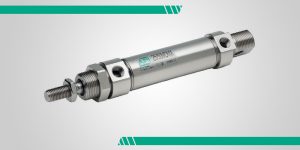How are Bricks Manufactured?
Bricks have been used as a building material for thousands of years, and they continue to be an essential part of construction today. Brick making combines clay, sand, water, and various additives to make a brick mould that is dried and fired. In this article, API UK will explore how bricks are manufactured and highlight the clear advantages of using pneumatic equipment throughout the brick making process.
WHAT IS BRICK MAKING?
Brick making is an ancient craft with a long history of providing solid and durable structures that can last centuries. As a result, brick making is an essential part of the construction industry and will continue to be a valuable resource for many years to come.
Modern automation incorporating various pneumatic equipment has improved the speed and accuracy of this process, allowing for more efficient production of high-quality bricks.
HOW ARE BRICKS MANUFACTURED?
While brick manufacturers will have their own specific processes, most brick making operations follow a similar approach. Manufacturing bricks typically involves the following tried and tested methods.
MINING AND PREPARATION
Bricks are manufactured from various materials, including shale, concrete and – crucially – clay, one of the world’s most abundant natural minerals. As such, most bricks are made of clay, mined from open pits and stored in vast storage areas.
The clay is then transported to the nearby preparation plant to be crushed before being mixed with water in a mixing chamber known as a ‘pug mill’. The tempered clay mixture is then ready for forming.
FORMING
There are three main brick forming techniques:
- Stiff-mud (extrusion)
- Soft-mud (moulding)
- Dry-press
The most popular method is the stiff-mud or extrusion approach, which involves de-airing the clay in a vacuum for added strength and plasticity before extruding the mixture through a die. The resulting clay column is sliced into individual bricks using an automatic wire cutter.
As the name suggests, soft-mud forming is reserved for slightly wetter clay mixes that are unsuitable for extrusion. This process often involves shaping clay in a sand-coated mould (to aid the removal of the brick), which is compacted via a hydraulic press in large-scale manufacturing operations.
Finally, dry-press forming involves pressing thicker clays into steel moulds using high pressure to form durable bricks.
DRYING AND FIRING
Once the brick has been formed, it then needs to be dried. Formed bricks can contain up to 30 per cent moisture, which must be removed to avoid cracking during the firing process. So bricks are dried in a drying chamber for 24 to 48 hours.
The bricks are then ready to be fired in a kiln (typically a tunnel kiln) at temperatures ranging from +800°C to +1400°C, depending on the type and size of the brick. Robots load the bricks onto a kiln car (a process known as ‘hacking’), which then passes through the various temperature zones of the tunnel kiln.
The firing process burns off impurities and binds the clay molecules together tightly to make the finished bricks more durable and resistant to weathering. Firing can take anywhere from a few hours to several days.
UNLOADING AND PACKING
After firing, the bricks are left to cool before being unloaded from the kiln car. This unloading process is carried out by robots once again (known as ‘de-hacking’), for the bricks to be stored, packaged and distributed.
PNEUMATICS IN BRICK MAKING
Pneumatic equipment is used in several key processing stages of the brick making process, predominantly in the form of pneumatic cylinders. For instance, pneumatic cylinders can often be found powering the clutches of extruders and the mixers used to blend the milled clay with other critical additives.
Cylinders are also commonly used to deliver the necessary pressure for dry-press brick forming and for powering the pneumatic grippers of automated hacking and de-hacking robots.
So, why should the modern brick manufacturer opt for pneumatic cylinders?
Not only do pneumatic cylinders deliver precise, repeatable performance, but their low maintenance requirements and durability make them a cost-effective choice.
Pneumatic cylinders are also simple to install and troubleshoot, and operate cleanly using a readily available power source. Plus, they meet explosion protection and machine safety requirements.

PNEUMATIC EQUIPMENT FROM API UK
The modern brick making plant lives and dies by the speed and volume of its output. From 2010 to 2018, UK brick deliveries rose by 28 per cent to more than two billion bricks, where it has largely remained ever since.
To meet such high demand, brick manufacturers require reliable, robust equipment that delivers a significant return on investment. Pneumatic cylinders tick all of those boxes and many more.
When sourcing the most competitive, expertly engineered pneumatic cylinders, look no further than API UK. Built from a metallic piston assembly, our cylinders are designed for heavy-duty applications common to brick making.
Furthermore, our 316 stainless steel pneumatic cylinders line delivers added longevity, reliability and corrosion resistance for even the most extreme processing environments.
To discuss your pneumatic cylinder requirements or arrange a free on-site visit, speak with our technical team today. As expert pneumatic cylinder manufacturers, we can help you understand the options available and guide you towards the best system solution for your application.
Call us today on 01782 206 995, email [email protected], or complete our contact form.
